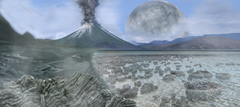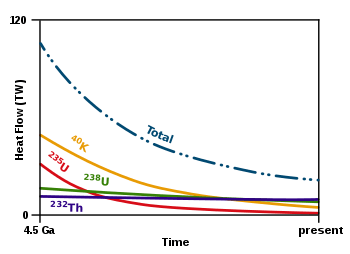Archean
The Archean Eon ( /ɑːrˈkiːən/ ar-KEE-ən, also spelled Archaean or Archæan) is one of the four geologic eons of Earth's history, occurring 4,000 to 2,500 million years ago (4 to 2.5 Gya). During the Archean, the Earth's crust had cooled enough to allow the formation of continents and the beginning of life on Earth.
| Archean Eon 4000–2500 million years ago | |
 Artist's impression of the Archean Eon. | |
-4500 — – -4000 — – -3500 — – -3000 — – -2500 — – -2000 — – -1500 — – -1000 — – -500 — – 0 — |
Etymology and changes in classification
The word 'Archean' comes from the ancient Greek word Αρχή (Arkhē), meaning 'beginning, origin.'[1] It was first used in 1872, when it meant "of the earliest geological age."[lower-alpha 1] Before the Hadean Eon was recognized, the Archean spanned Earth's early history from its formation about 4,540 million years ago (Mya) until 2,500 Mya.
Instead of being based on stratigraphy, the beginning and end of the Archean Eon are defined chronometrically. The eon's lower boundary or starting point of 4 Gya (4 billion years ago) is officially recognized by the International Commission on Stratigraphy.[3]
Geology
When the Archean began, the Earth's heat flow was nearly three times as high as it is today, and it was still twice the current level at the transition from the Archean to the Proterozoic (2,500 Ma). The extra heat was the result of a mix of remnant heat from planetary accretion, from the formation of the metallic core, and from the decay of radioactive elements.
Although a few mineral grains are known to be Hadean, the oldest rock formations exposed on the surface of the Earth are Archean. Archean rocks are found in Greenland, Siberia, the Canadian Shield, Montana and Wyoming (exposed parts of the Wyoming Craton), the Baltic Shield, the Rhodope Massif, Scotland, India, Brazil, western Australia, and southern Africa. Granitic rocks predominate throughout the crystalline remnants of the surviving Archean crust. Examples include great melt sheets and voluminous plutonic masses of granite, diorite, layered intrusions, anorthosites and monzonites known as sanukitoids. Archean rocks are often heavily metamorphized deep-water sediments, such as graywackes, mudstones, volcanic sediments, and banded iron formations. Volcanic activity was considerably higher than today, with numerous lava eruptions, including unusual types such as komatiite.[4] Carbonate rocks are rare, indicating that the oceans were more acidic due to dissolved carbon dioxide than during the Proterozoic.[5] Greenstone belts are typical Archean formations, consisting of alternating units of metamorphosed mafic igneous and sedimentary rocks, including Archean felsic volcanic rocks. The metamorphosed igneous rocks were derived from volcanic island arcs, while the metamorphosed sediments represent deep-sea sediments eroded from the neighboring island arcs and deposited in a forearc basin. Greenstone belts, being both types of metamorphosed rock, represent sutures between the protocontinents.[6](pp302–303)

The Earth's continents started to form in the Archean, although details about their formation are still being debated, due to lack of extensive geological evidence. One hypothesis is that rocks that are now in India, western Australia, and southern Africa formed a continent called Ur as of 3,100 Ma.[7] A differing conflicting hypothesis is that rocks from western Australia and southern Africa were assembled in a continent called Vaalbara as far back as 3,600 Ma.[8] Although the first continents formed during this eon, rock of this age makes up only 7% of the present world's cratons; even allowing for erosion and destruction of past formations, evidence suggests that only 5–40% of the present area of continents formed during the Archean.[6](pp301–302)
By the end of the Archean around 2500 Ma (2.5 Gya), plate tectonic activity may have been similar to that of the modern Earth. There are well-preserved sedimentary basins, and evidence of volcanic arcs, intracontinental rifts, continent-continent collisions and widespread globe-spanning orogenic events suggesting the assembly and destruction of one and perhaps several supercontinents. Evidence from banded iron formations, chert beds, chemical sediments and pillow basalts demonstrates that liquid water was prevalent and deep oceanic basins already existed.
Environment

The Archean atmosphere is thought to have nearly lacked free oxygen. Astronomers think that the Sun had about 70–75 percent of the present luminosity, yet temperatures on Earth appear to have been near modern levels after only 500 Ma of Earth's formation (the faint young Sun paradox). The presence of liquid water is evidenced by certain highly deformed gneisses produced by metamorphism of sedimentary protoliths. The moderate temperatures may reflect the presence of greater amounts of greenhouse gases than later in the Earth's history.[9][10] Alternatively, Earth's albedo may have been lower at the time, due to less land area and cloud cover.[11]
Early life
The processes that gave rise to life on Earth are not completely understood, but there is substantial evidence that life came into existence either near the end of the Hadean Eon or early in the Archean Eon.
The earliest evidence for life on Earth are graphite of biogenic origin found in 3.7 billion-year-old metasedimentary rocks discovered in Western Greenland.[12]
The earliest identifiable fossils consist of stromatolites, which are microbial mats formed in shallow water by cyanobacteria. The earliest stromatolites are found in 3.48 billion-year-old sandstone discovered in Western Australia.[13][14] Stromatolites are found throughout the Archean[15] and become common late in the Archean.[6](p307) Cyanobacteria were instrumental in creating free oxygen in the atmosphere.[16]
Further evidence for early life is found in 3.47 billion-year-old baryte, in the Warrawoona Group of Western Australia. This mineral shows sulfur fractionation of as much as 21.1%,[17] which is evidence of sulfate-reducing bacteria that metabolize sulfur-32 more readily than sulfur-34.[18]
Evidence of life in the Late Hadean is more controversial. In 2015, biogenic carbon was detected in zircons dated to 4.1 billion years ago, but this evidence is preliminary and needs validation.[19][20]
Earth was very hostile to life before 4.2–4.3 Ga and the conclusion is that before the Archean Eon, life as we know it would have been challenged by these environmental conditions. While life could have arisen before the Archean, the conditions necessary to sustain life could not have occurred until the Archean Eon.[21]
Life in the Archean was limited to simple single-celled organisms (lacking nuclei), called Prokaryota. In addition to the domain Bacteria, microfossils of the domain Archaea have also been identified. There are no known eukaryotic fossils from the earliest Archean, though they might have evolved during the Archean without leaving any.[6](pp306,323) Fossil steranes, indicative of eukaryotes, have been reported from Archean strata but were shown to derive from contamination with younger organic matter.[22] No fossil evidence has been discovered for ultramicroscopic intracellular replicators such as viruses.
Fossilized microbes from terrestrial microbial mats show that life was already established on land 3.22 billion years ago.[23]
See also
- Abiogenesis – The natural process by which life arises from non-living matter
- Cosmic Calendar
- Earliest known life forms – Putative fossilized microorganisms found near hydrothermal vents
- Geologic time scale – system that relates geological strata to time
- History of Earth – The development of planet Earth from its formation to the present day
- Precambrian – The earliest part of Earth's history: 4600–541 million years ago
- Timeline of natural history
- Archean felsic volcanic rocks
Footnotes
- The name Archean was coined by American geologist James Dwight Dana (1813–1895).[2] The Pre-Cambrian eon had been believed to be without life (azoic); however, because fossils had been found in deposits that had been judged to belong to the Azoic age, "... I propose to use for the Azoic era and its rocks the general term Archæn (or Arche'an), from the Greek άρχαιος, pertaining to the beginning."[2](p253)
References
- Harper, Douglas. "Archaean". Online Etymology Dictionary.
- Dana JD (1872). "Green Mountain geology. On the quartzite". American Journal of Science and Arts. 3rd series. 3 (16): 250–257.
- "International Chronostratigraphic Chart v.2013/01" (PDF). International Commission on Stratigraphy. January 2013. Retrieved 6 April 2013.
- Dostal J (2008). "Igneous Rock Associations 10. Komatiites". Geoscience Canada. 35 (1).
- Cooper JD, Miller RH, Patterson J (1986). A Trip Through Time: Principles of historical geology. Columbus: Merrill Publishing Company. p. 180. ISBN 978-0675201407.
- Stanley, Steven M. (1999). Earth System History. New York: W.H. Freeman and Company. ISBN 978-0716728825.
- Rogers JJ (1996). "A history of continents in the past three billion years". Journal of Geology. 104 (1): 91–107. Bibcode:1996JG....104...91R. doi:10.1086/629803. JSTOR 30068065.
- Cheney ES (1996). "Sequence stratigraphy and plate tectonic significance of the Transvaal succession of southern Africa and its equivalent in Western Australia". Precambrian Research. 79 (1–2): 3–24. Bibcode:1996PreR...79....3C. doi:10.1016/0301-9268(95)00085-2.
- Walker, James C.G. (June 1985). "Carbon dioxide on the early earth" (PDF). Origins of Life and Evolution of the Biosphere. 16 (2): 117–127. Bibcode:1985OrLi...16..117W. doi:10.1007/BF01809466. hdl:2027.42/43349. PMID 11542014. Retrieved 30 January 2010.
- Pavlov AA, Kasting JF, Brown LL, Rages KA, Freedman R (May 2000). "Greenhouse warming by CH4 in the atmosphere of early Earth". Journal of Geophysical Research. 105 (E5): 11981–11990. Bibcode:2000JGR...10511981P. doi:10.1029/1999JE001134. PMID 11543544.
- Rosing MT, Bird DK, Sleep NH, Bjerrum CJ (April 2010). "No climate paradox under the faint early Sun". Nature. 464 (7289): 744–747. Bibcode:2010Natur.464..744R. doi:10.1038/nature08955. PMID 20360739.
- Ohtomo Y, Kakegawa T, Ishida A, Nagase T, Rosing MT (8 December 2013). "Evidence for biogenic graphite in early Archaean Isua metasedimentary rocks". Nature Geoscience. 7 (1): 25–28. Bibcode:2014NatGe...7...25O. doi:10.1038/ngeo2025.
- Borenstein, Seth (13 November 2013). "Oldest fossil found: Meet your microbial mom". AP News. Retrieved 15 November 2013.
- Noffke N, Christian D, Wacey D, Hazen RM (December 2013). "Microbially induced sedimentary structures recording an ancient ecosystem in the ca. 3.48 billion-year-old Dresser Formation, Pilbara, Western Australia". Astrobiology. 13 (12): 1103–1124. Bibcode:2013AsBio..13.1103N. doi:10.1089/ast.2013.1030. PMC 3870916. PMID 24205812.
- Garwood, Russell J. (2012). "Patterns In Palaeontology: The first 3 billion years of evolution". Palaeontology Online. 2 (11): 1–14. Retrieved 25 June 2015.
- "Early life: Oxygen enters the atmosphere". BBC. Retrieved 20 September 2012.
- Shen Y, Buick R, Canfield DE (March 2001). "Isotopic evidence for microbial sulphate reduction in the early Archaean era". Nature. 410 (6824): 77–81. Bibcode:2001Natur.410...77S. doi:10.1038/35065071. PMID 11242044.
- Seal RR (2006). "Sulfur isotope geochemistry of sulfide minerals". Reviews in Mineralogy and Geochemistry. 61 (1): 633–677. Bibcode:2006RvMG...61..633S. doi:10.2138/rmg.2006.61.12.
- Borenstein S (19 October 2015). "Hints of life on what was thought to be desolate early Earth". Excite. Yonkers, NY: Mindspark Interactive Network. Associated Press. Retrieved 20 October 2015.
- Bell EA, Boehnke P, Harrison TM, Mao WL (November 2015). "Potentially biogenic carbon preserved in a 4.1 billion-year-old zircon". Proceedings of the National Academy of Sciences of the United States of America (Early, published online before print ed.). 112 (47): 14518–14521. Bibcode:2015PNAS..11214518B. doi:10.1073/pnas.1517557112. PMC 4664351. PMID 26483481.
- Nisbet, Euan (1980). "Archaeon stromatolites and the search for the earliest life". Nature. 284 (5755): 395–396. Bibcode:1980Natur.284..395N. doi:10.1038/284395a0.
- French KL, Hallmann C, Hope JM, Schoon PL, Zumberge JA, Hoshino Y, Peters CA, George SC, Love GD, Brocks JJ, Buick R, Summons RE (May 2015). "Reappraisal of hydrocarbon biomarkers in Archean rocks". Proceedings of the National Academy of Sciences of the United States of America. 112 (19): 5915–5920. Bibcode:2015PNAS..112.5915F. doi:10.1073/pnas.1419563112. PMC 4434754. PMID 25918387.
- Woo, Marcus (30 July 2018). "Oldest Evidence for life on land unearthed in South Africa". livescience.com.
External links
| Wikimedia Commons has media related to Archean. |
| Wikisource has the text of the 1911 Encyclopædia Britannica article Archean system. |
- "Archean". GeoWhen Database. stratigraphy.org.
- "When did plate tectonics begin?". utdallas.edu. University of Texas – Dallas.
- "Archean (chronostratigraphy scale)". ghkclass.com.